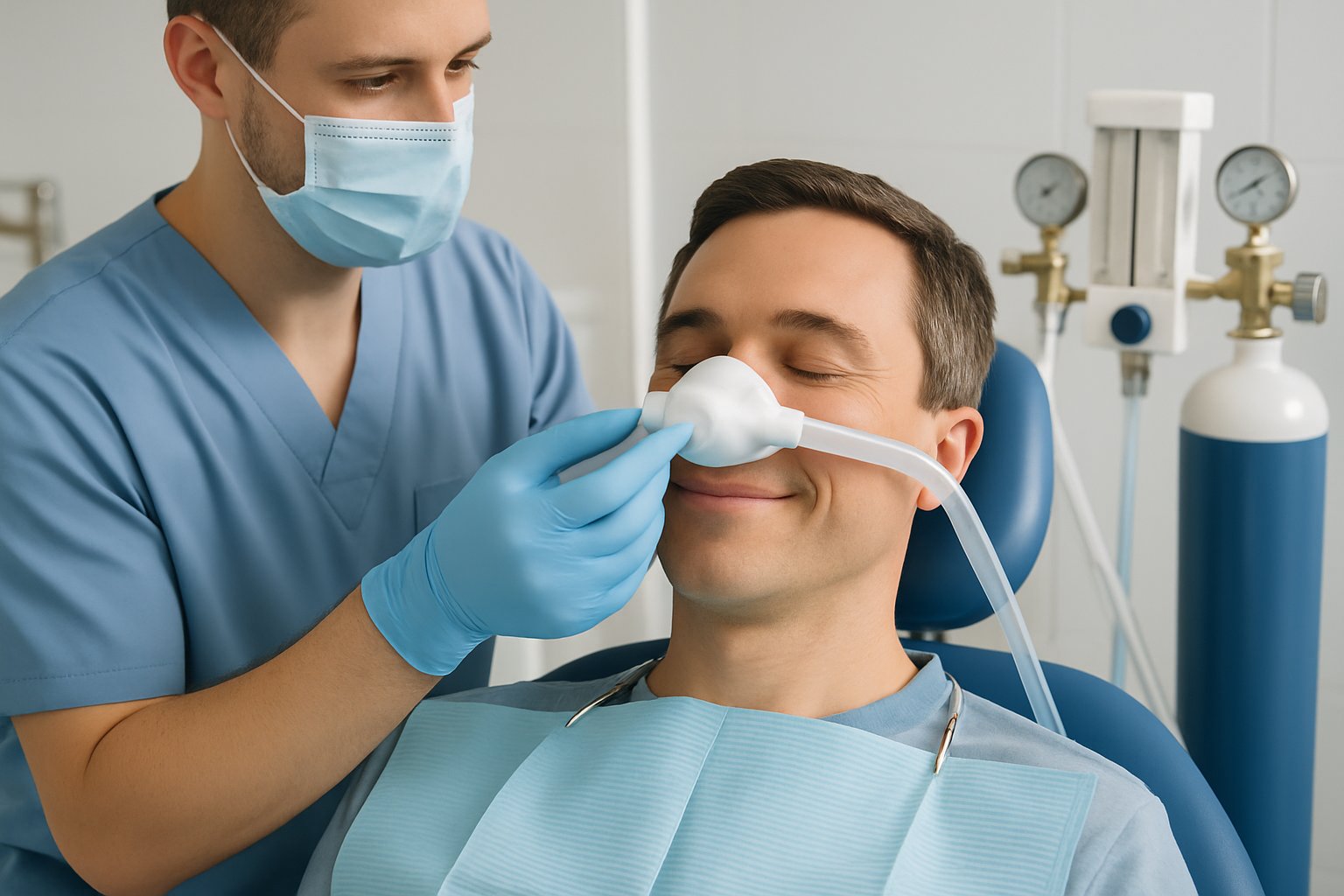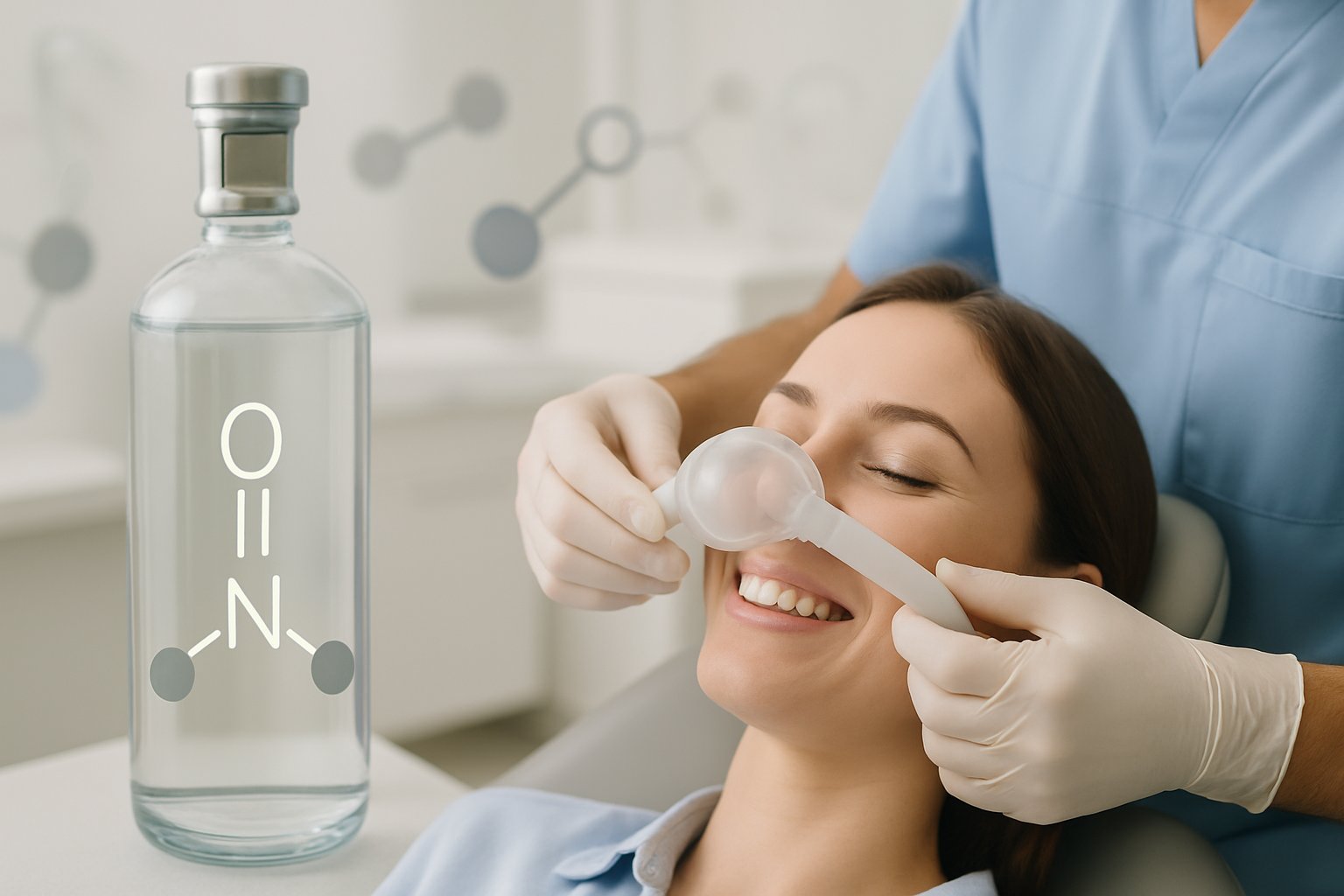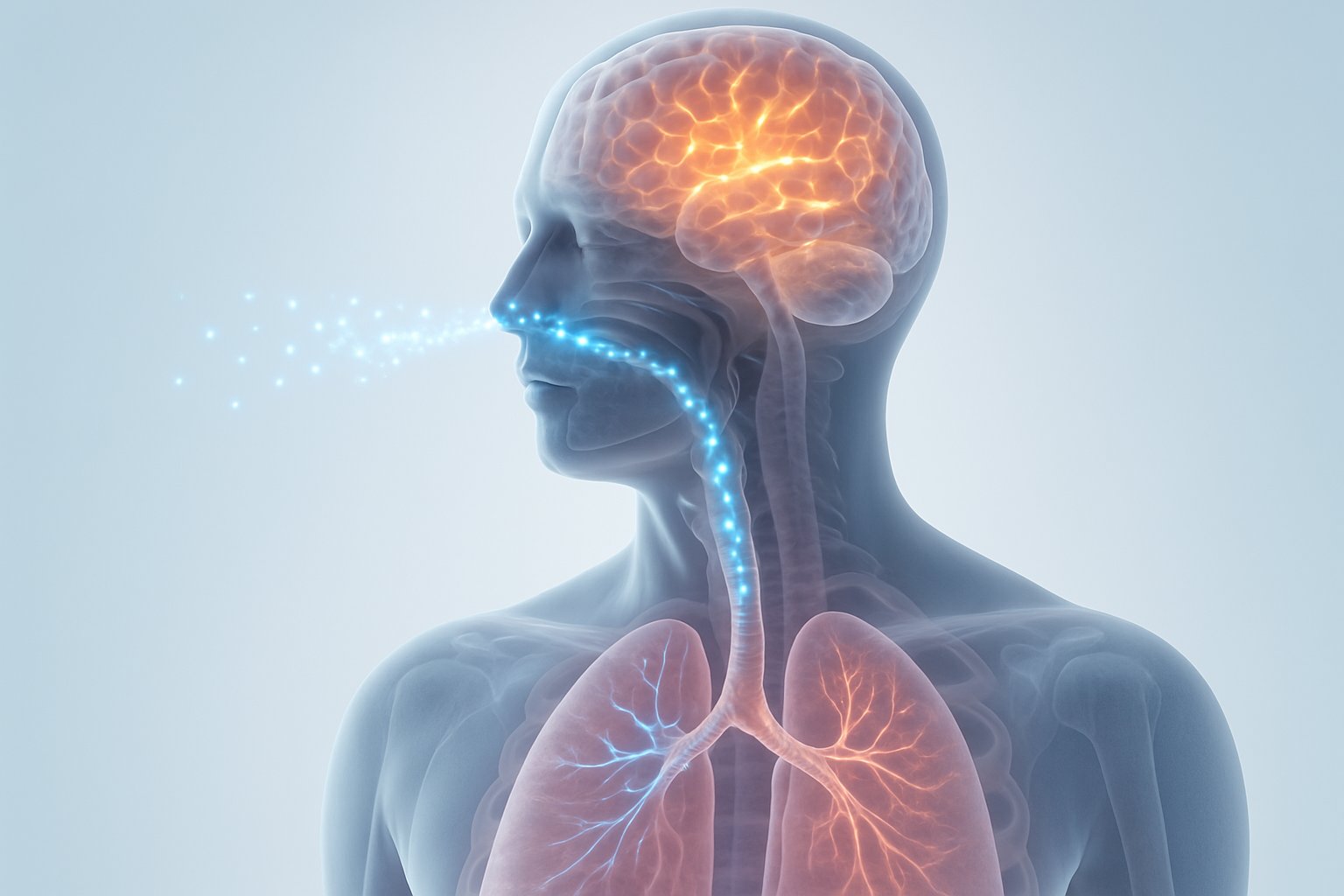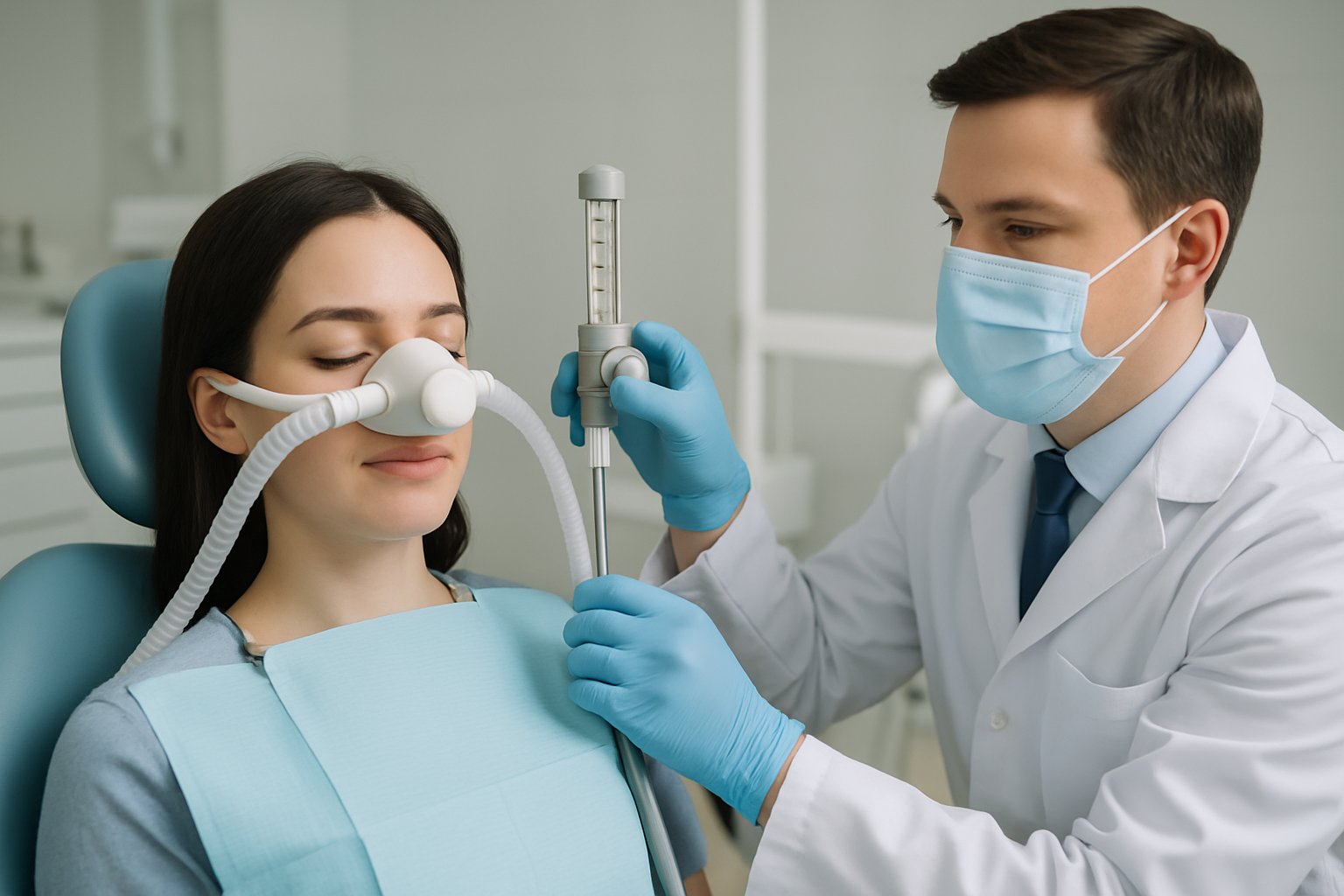How Nitrous Oxide (Laughing Gas) Works

Nitrous oxide, often called laughing gas, has helped people relax during medical and dental procedures for decades. It slows the body’s response to pain and creates a calm, light feeling.
We inhale nitrous oxide through a small mask. Within minutes, it starts to take effect.
We stay awake and aware while the gas changes how our brain processes pain and anxiety. This helps us stay comfortable without heavy sedation.
The effects wear off quickly once we stop breathing it in. That’s why dentists often choose it.
Key Takeaways
- Nitrous oxide reduces pain and anxiety without putting us to sleep
- The effects start within minutes and fade quickly after use
- Dentists use it for comfort and safety during treatments
What Is Nitrous Oxide?

Nitrous oxide is a colorless gas with a slightly sweet smell. Medical and dental professionals use it to help manage pain and anxiety.
We often encounter nitrous oxide in dental offices and surgical settings. Its long history of study and use shapes how we understand it today.
Chemical Properties and Discovery
Nitrous oxide (N₂O) contains two nitrogen atoms and one oxygen atom. It is non-flammable but can make other materials burn more easily.
At room temperature, nitrous oxide is a gas. Under pressure, it becomes a liquid.
English chemist Joseph Priestley discovered nitrous oxide in 1772 while heating ammonium nitrate. In the 1790s, Humphry Davy studied its effects and noted its ability to produce euphoria and reduce pain.
Its molecular structure makes it stable under normal conditions. When heated to high temperatures, it breaks down into nitrogen and oxygen.

Common Uses in Medicine and Dentistry
Medical and dental professionals use nitrous oxide as a mild sedative and pain reliever. We often combine it with oxygen and deliver it through a mask.
Patients stay awake but feel more relaxed and less sensitive to discomfort. Dentists use it during procedures such as fillings, cleanings, and extractions.
Nitrous oxide helps reduce anxiety, especially for children or patients with dental phobia. Its effects wear off quickly after inhalation stops, so most people can resume normal activities soon after treatment.
Hospitals may use nitrous oxide with other anesthetics during surgeries. Its safety profile and fast recovery time make it a preferred choice for many short procedures.
How Nitrous Oxide Got the Name ‘Laughing Gas’
People call it “laughing gas” because it sometimes causes short bursts of laughter or giggling. Inhaling nitrous oxide can create a light, euphoric feeling.
This effect is temporary and fades quickly once we breathe normal air again. Humphry Davy observed this reaction during his experiments and noted the mood-lifting effects.
Early 19th-century public demonstrations made these reactions widely known. Today, we focus on its ability to ease pain and anxiety in medical settings.
How Nitrous Oxide Works in the Body

Nitrous oxide changes how our nervous system sends and processes signals. It affects brain activity, alters pain perception, and can influence mood within minutes.
Mechanism of Action
When we inhale nitrous oxide, it quickly enters the lungs and moves into the bloodstream. Because it is not very soluble in blood, it reaches the brain rapidly.
Nitrous oxide interacts with several neurotransmitter systems, including NMDA receptors linked to pain and memory. By blocking these receptors, it reduces the brain’s ability to register pain signals.
It also stimulates the release of endorphins and dopamine. These chemicals change how we experience discomfort.
The gas leaves the body quickly and is exhaled almost entirely within minutes.
Effects on the Brain and Nervous System
Nitrous oxide slows down nerve signal transmission. This can cause a light, floating feeling and mild sedation.
It reduces the activity of certain brain regions that process sensory input. Sounds may seem distant, and time can feel altered.
The gas also increases activity in reward pathways, which contributes to its mood effects.
In higher concentrations, nitrous oxide can cause dizziness, tingling in the limbs, and mild visual changes. We must ensure a proper oxygen supply during use because oxygen levels in the blood may drop without enough fresh air.
Euphoria and Mood Changes
Many people feel euphoria within seconds of breathing nitrous oxide. This feeling links to increased dopamine in the brain’s reward centers.
The pleasant mood shift lasts only a few minutes after inhalation stops. Some may also feel relaxed, giggly, or less self-conscious.
These effects can reduce anxiety during medical or dental procedures. However, the mood lift is short-lived, and repeated use without oxygen can cause headaches, nausea, or, in rare cases, oxygen deprivation.
Nitrous Oxide in Dentistry

Dentists use nitrous oxide to help patients stay calm, reduce discomfort, and make procedures easier to complete. It works quickly and allows most people to return to normal activities soon after treatment.
Role in Dental Procedures
Patients inhale nitrous oxide through a small mask placed over the nose. We mix it with oxygen and adjust the flow to achieve the desired effect.
Nitrous oxide does not put patients to sleep. It helps them feel relaxed while staying awake and able to respond to instructions.
Dentists use it for procedures such as fillings, cleanings, extractions, and crown placements. It can be especially helpful for patients with dental anxiety or a strong gag reflex.
Because it takes effect within minutes, we can start treatment soon after administration. When the procedure ends, we stop the nitrous oxide and give pure oxygen to help clear it from the body.
Benefits for Dental Appointments
Nitrous oxide offers several practical benefits:

It also helps reduce mild pain and makes time feel shorter for the patient.
Because patients inhale it, nitrous oxide does not require needles or pills. This can be a relief for those who dislike injections.
We can use it for both children and adults, making it a versatile option for many dental appointments.
Safety and Monitoring During Use
We follow strict safety protocols when we use nitrous oxide. The gas is always mixed with at least 30% oxygen to prevent low oxygen levels.
We monitor breathing, comfort, and responsiveness throughout the procedure. The mask stays in place only as long as needed, and we adjust levels if the patient feels too lightheaded or uncomfortable.
Nitrous oxide leaves the system quickly once inhalation stops. This makes it safer than some other sedatives that linger for hours.
We also ensure the treatment room has proper ventilation to prevent gas buildup in the air.
Recovery and Aftercare
After treatment, we give 100% oxygen for about 3–5 minutes to flush out any remaining nitrous oxide. This helps prevent headaches and speeds recovery.
Most patients can drive themselves home and return to work or school the same day.
We advise eating a light meal before the appointment to reduce the risk of nausea. If any dizziness or mild headache occurs, it usually passes within minutes.
No special restrictions are needed after nitrous oxide use. We recommend resting if the patient feels tired.
Frequently Asked Questions
We can explain how nitrous oxide affects the body and its possible risks. We also discuss how it compares to other sedation options and the chemical processes involved during use.
What are the side effects of using nitrous oxide for dental procedures?
Common side effects include dizziness, nausea, and mild headache.
Some people may feel tingling in their arms or legs.
These effects usually fade within minutes after the gas is stopped.
How does nitrous oxide induce sedation in patients?
Nitrous oxide slows down the body’s response to stimulation by affecting the central nervous system.
It increases the activity of calming neurotransmitters and reduces signals linked to pain and anxiety.
This creates a relaxed but conscious state.
What are the long-term effects of repeated nitrous oxide exposure?
Frequent exposure without proper safety measures can lower vitamin B12 levels.
This can lead to nerve damage or anemia over time.
Proper ventilation and limited use reduce these risks.
Can you describe the chemical process of nitrous oxide when inhaled?
When we inhale nitrous oxide, it enters the lungs and moves into the bloodstream.
It quickly reaches the brain, where it alters nerve signal transmission.
The gas does not break down in the body and is exhaled unchanged.
How does nitrous oxide affect the body during medical procedures?
Nitrous oxide reduces the perception of pain and helps lower anxiety.
Breathing and heart rate usually remain stable under its effects.
Patients stay awake and can respond to instructions.
What are the alternative sedation methods to nitrous oxide in dentistry?
Dentists can use oral sedatives, intravenous (IV) sedation, and local anesthesia as alternatives.
Oral sedatives act more slowly but their effects last longer.
IV sedation offers deeper relaxation and needs more careful monitoring.
📞 Contact Kaufman Dentistry Today
Give us a call at (310) 838-7780 to schedule your appointment and take the first step towards a stunning smile.
You can find us at 10760 Washington Blvd., Culver City, CA 90232. We look forward to welcoming you to our practice and helping you achieve the smile of your dreams!
